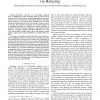Free Online Productivity Tools
i2Speak
i2Symbol
i2OCR
iTex2Img
iWeb2Print
iWeb2Shot
i2Type
iPdf2Split
iPdf2Merge
i2Bopomofo
i2Arabic
i2Style
i2Image
i2PDF
iLatex2Rtf
Sci2ools
INFOCOM
2009
IEEE
2009
IEEE
Multi-VPN Optimization for Scalable Routing via Relaying
—Enterprise networks are increasingly adopting Layer 3 Multiprotocol Label Switching (MPLS) Virtual Private Network (VPN) technology to connect geographically disparate locations. The any-to-any direct connectivity model of this technology involves a very high memory footprint and is causing associated routing tables in the service provider’s routers to grow very large. The concept of Relaying was proposed earlier [9] to separately minimize the routing table memory footprint of individual VPNs, and involves selecting a small number of hub routers to maintain complete reachability information for that VPN, and enabling non-hub spoke routers with reduced routing tables to achieve any-to-any reachability by routing traffic via a hub. A large service provider network typically hosts many thousands of different VPNs. In this paper, we generalize Relaying to the multi-VPN environment, and consider new constraints on resources shared across VPNs, such as router uplink bandwidth and memor...
Related Content
| Added | 24 May 2010 |
| Updated | 24 May 2010 |
| Type | Conference |
| Year | 2009 |
| Where | INFOCOM |
| Authors | MohammadHossein Bateni, Alexandre Gerber, Mohammad Taghi Hajiaghayi, Subhabrata Sen |
Comments (0)

